Install the app
How to install the app on iOS
Follow along with the video below to see how to install our site as a web app on your home screen.

Note: This feature currently requires accessing the site using the built-in Safari browser.
You are using an out of date browser. It may not display this or other websites correctly.
You should upgrade or use an alternative browser.
You should upgrade or use an alternative browser.
Ghurier
Regular Member
- Messages
- 167
- Reaction score
- 111
- Points
- 43
- Y-DNA haplogroup
- J-L283-->J-Z631
- mtDNA haplogroup
- U5b2b
Smoothed version:
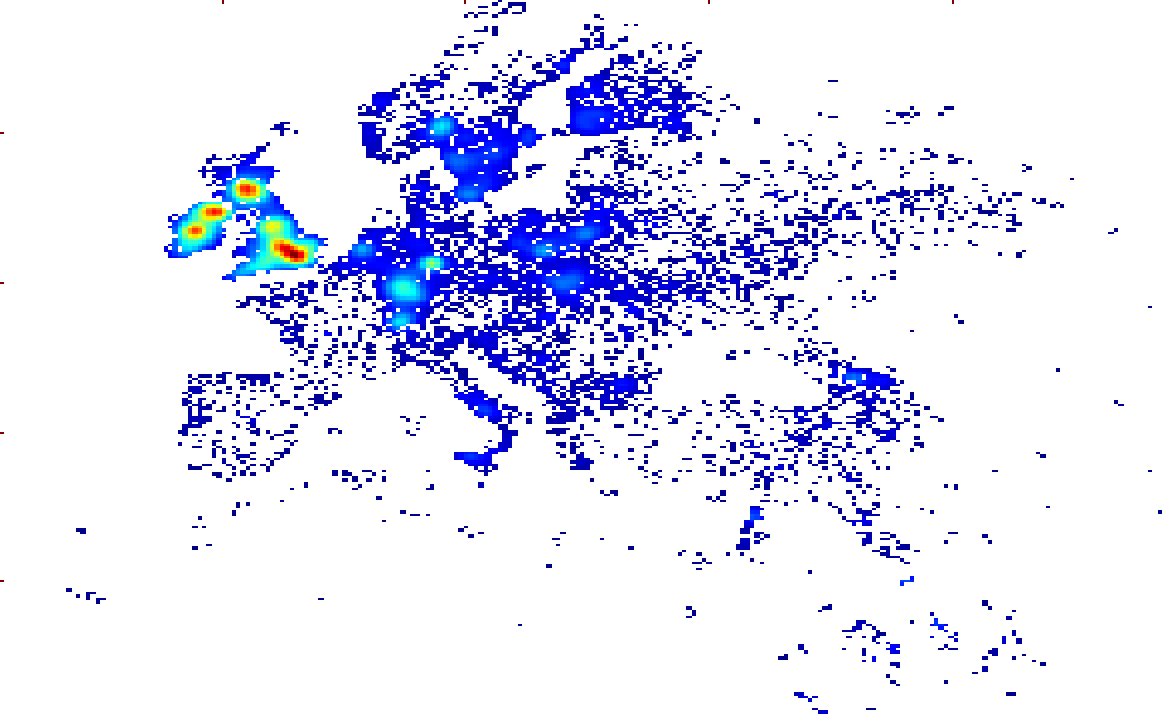
A map including J2-L283s (orange + red dots) from the same dataset (I added the country border this time) :

PS: date BP in parenthesis gives the TMRCA according to YFULL.

A map including J2-L283s (orange + red dots) from the same dataset (I added the country border this time) :

PS: date BP in parenthesis gives the TMRCA according to YFULL.
Ghurier
Regular Member
- Messages
- 167
- Reaction score
- 111
- Points
- 43
- Y-DNA haplogroup
- J-L283-->J-Z631
- mtDNA haplogroup
- U5b2b
Hi,
To elaborate a bit on the difference between number count of haplogroup carriers, percentage of carrier, and diverity of carrier, find below 15 maps.
From left to right : Number count, density, and disersity of haplogroup carriers.
From top to bottom : J-Z1043, J-Z631, J-Z597, J-Z585, and J-L283.
The data I use here are from FTDNA J2-group, it is a very small dataset, and therefore statistical noise is important.
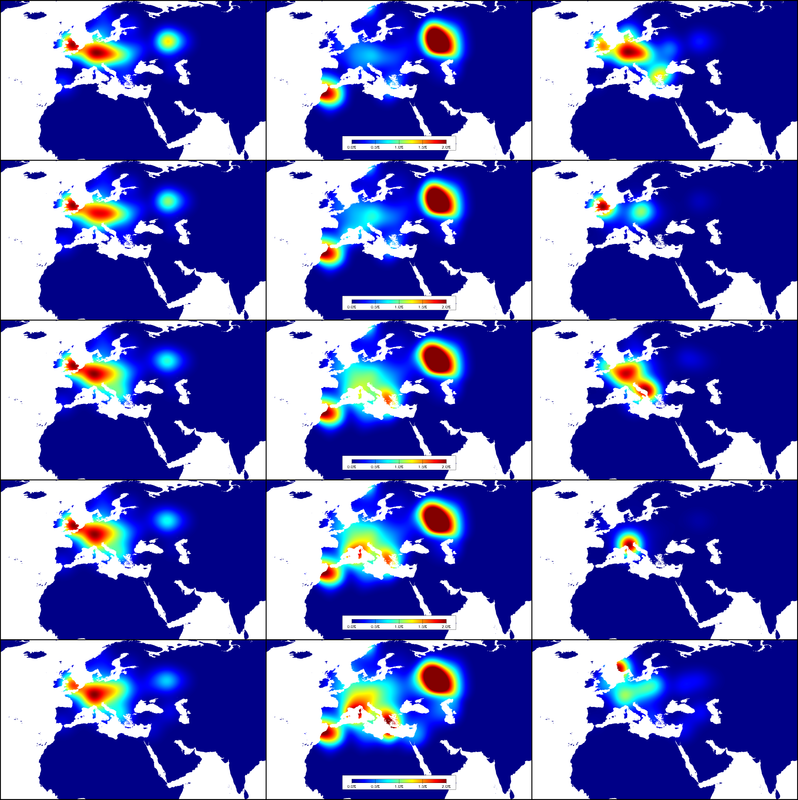
On top of that, by construction diversity is still biased toward oversampled regions (because in oversampled regions you are more likely to find many subclades that in severely undersampled regions). Such bias disapear once all region reach a sufficient sampling but ar still present in this case.
Consequently, I won't believe too much the diversity cluster in UK for J-Z631.
I used 50 years time range to compute the diversity (meaning each child line with a formation time that is less than 50 years after the concerned haplogroup have a total weight of 1 on the map), except for J-Z597 where I used 500, to include diffusion stages from 2400BC to 1900BC. Therefore, considering the wide time range the South German and Illyrian diversity clusters might represent something real.
Globally, we see that diversity is very efficient to clean founder effects (see how the Russian cluster disappear for diversity in all maps). And even if partially biased toward oversampled regions, it is less biased than raw number count.
For reference, I just give below the "coverage" map (with the same smoothing and display style), this is a number count map of the peoples in FTDNA groups (considering all major haplogroups). Note that the south-western germany oversampled region is not visible due to the intense smoothing I applied (to compensate from the small-statistic situation we are with this dataset).
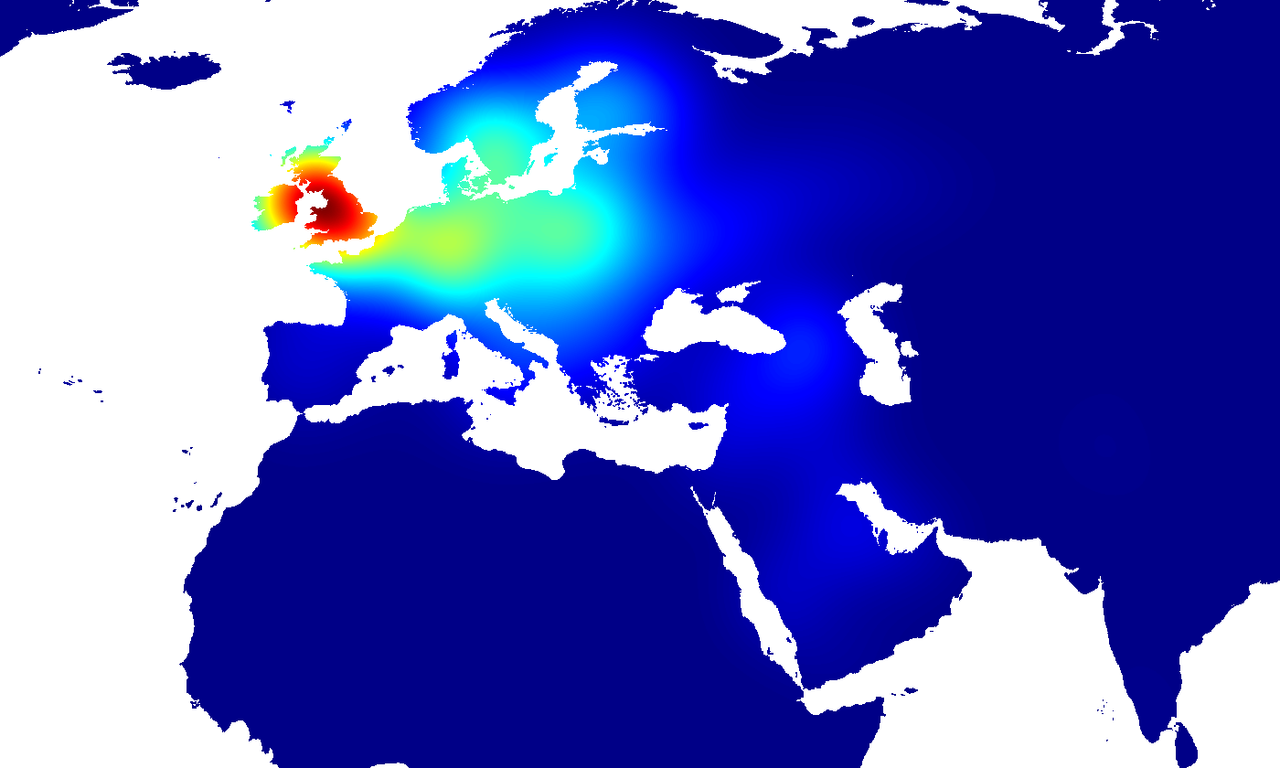
To elaborate a bit on the difference between number count of haplogroup carriers, percentage of carrier, and diverity of carrier, find below 15 maps.
From left to right : Number count, density, and disersity of haplogroup carriers.
From top to bottom : J-Z1043, J-Z631, J-Z597, J-Z585, and J-L283.
The data I use here are from FTDNA J2-group, it is a very small dataset, and therefore statistical noise is important.

On top of that, by construction diversity is still biased toward oversampled regions (because in oversampled regions you are more likely to find many subclades that in severely undersampled regions). Such bias disapear once all region reach a sufficient sampling but ar still present in this case.
Consequently, I won't believe too much the diversity cluster in UK for J-Z631.
I used 50 years time range to compute the diversity (meaning each child line with a formation time that is less than 50 years after the concerned haplogroup have a total weight of 1 on the map), except for J-Z597 where I used 500, to include diffusion stages from 2400BC to 1900BC. Therefore, considering the wide time range the South German and Illyrian diversity clusters might represent something real.
Globally, we see that diversity is very efficient to clean founder effects (see how the Russian cluster disappear for diversity in all maps). And even if partially biased toward oversampled regions, it is less biased than raw number count.
For reference, I just give below the "coverage" map (with the same smoothing and display style), this is a number count map of the peoples in FTDNA groups (considering all major haplogroups). Note that the south-western germany oversampled region is not visible due to the intense smoothing I applied (to compensate from the small-statistic situation we are with this dataset).

Archetype0ne
Regular Member
- Messages
- 1,738
- Reaction score
- 636
- Points
- 113
- Ethnic group
- Albanian
- Y-DNA haplogroup
- L283>Y21878>Y197198
Well done bro!
Fantastic exercise in data science.
From what I can gather there might have been two routes with three movements into Europe.
1)Two through the southern mouth of the Carpathians
a)one through the Danube and then through estuaries into the Rhine, while the other
b)into Southern Balkans, and
2)one over the northern range of the Carpathians straight into central Europe.
Say first two rows from the images you posted could be 2), while bottom three rose (a) and/or (b).
But I suspect there was overlap between these three scenarios which could have been not haplogroup (mutually) exclusive.
Fantastic exercise in data science.
From what I can gather there might have been two routes with three movements into Europe.
1)Two through the southern mouth of the Carpathians
a)one through the Danube and then through estuaries into the Rhine, while the other
b)into Southern Balkans, and
2)one over the northern range of the Carpathians straight into central Europe.
Say first two rows from the images you posted could be 2), while bottom three rose (a) and/or (b).
But I suspect there was overlap between these three scenarios which could have been not haplogroup (mutually) exclusive.
TaktikatEMalet
Regular Member
- Messages
- 764
- Reaction score
- 125
- Points
- 43
- Y-DNA haplogroup
- i2a WHG
Illyrians, Daco-Thracians, Greeks most likely, but could also be from other people. The frequencies seem to be so low, many might be just individual migrants with subsequent founder effects, similar to Chinese samples of the same kind, most likely from Iranian speakers via Thraco-Scythian steppe backflow.
Daco thracian source not possible, as roman conquests went in this order - illyria + greece, tunisia, THEN thrace
The r1b z2103 and v13 in tunisia cannot be from thrace
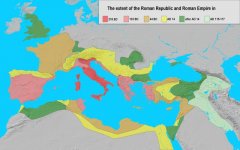
Last edited:
TaktikatEMalet
Regular Member
- Messages
- 764
- Reaction score
- 125
- Points
- 43
- Y-DNA haplogroup
- i2a WHG
Pal, you need to read up on history more before writing on hereIllyri proprie dicti was a term to indicate illyrian tribes in modern Montenegro ...............most of the tribes are Montenegro except the Taulanti who are in Albania ......but we know that the Taulanti where wiped out by the invading macedonians in 314BC
There is still questions if the Taulanti where originally Dardanians ...one of the 3 major tribes.
of the other tribes most are coming south from ancient southern Pannonia which is part of modern Bosnia

The romans named an entire region for illyrians hundreds of years after you claim they were wiped out -
Illyricum /ɪˈlɪrɪkəm/ was a Roman province that existed from 27 BC to sometime during the reign of Vespasian (69–79 AD).
Do you even know that the illyrian roman wars are also after 314bc??
Taulanti may have been severely weakened by the macedonians in 314bc but what has this got to do with illyrians overall? Taulantii were 1 tribe - its like a clan/fis. There were hundreds of different illyrian clans/fis and some survived better than others like you said Dardani being one of the bigger tribes (though werent they partly thracian?). Tribes like dardani were much more numerous and were likely a unification of different clans which is why they were a bigger force
Galaxy Overlord
Regular Member
- Messages
- 75
- Reaction score
- 55
- Points
- 18
- Y-DNA haplogroup
- J2b-L283>Z631>?
- mtDNA haplogroup
- H>?
There is a lot of claiming J-l283 as proto-Illyrian when we have so few ancient samples. What is the logic behind this assumption? Is it simply because it's heavily present in modern Albania? Couldn't this just be a mountainous refuge region where groups got pushed back by the R1a?
There is a lot of claiming J-l283 as proto-Illyrian when we have so few ancient samples. What is the logic behind this assumption? Is it simply because it's heavily present in modern Albania? Couldn't this just be a mountainous refuge region where groups got pushed back by the R1a?
It was found too often in an Illyrian related context already. I would assume it spread early to other people too, possibly including Celts or para-Celtic Alpine and North Italian groups, but if associating it with one historically known ethnicity, its definitely Illyrian first as of now. Let's see what additional samples might reveal.
torzio
Regular Member
- Messages
- 3,970
- Reaction score
- 1,234
- Points
- 113
- Location
- Eastern Australia
- Ethnic group
- North East Italian
- Y-DNA haplogroup
- T1a2 - SK1480
- mtDNA haplogroup
- H95a
It was found too often in an Illyrian related context already. I would assume it spread early to other people too, possibly including Celts or para-Celtic Alpine and North Italian groups, but if associating it with one historically known ethnicity, its definitely Illyrian first as of now. Let's see what additional samples might reveal.
IIRC...this marker is also found in the recent ancient slovenian samples paper ..................they are not slavic, so do not bring this up
torzio
Regular Member
- Messages
- 3,970
- Reaction score
- 1,234
- Points
- 113
- Location
- Eastern Australia
- Ethnic group
- North East Italian
- Y-DNA haplogroup
- T1a2 - SK1480
- mtDNA haplogroup
- H95a
Pal, you need to read up on history more before writing on here
The romans named an entire region for illyrians hundreds of years after you claim they were wiped out -
Illyricum /ɪˈlɪrɪkəm/ was a Roman province that existed from 27 BC to sometime during the reign of Vespasian (69–79 AD).
Do you even know that the illyrian roman wars are also after 314bc??
Taulanti may have been severely weakened by the macedonians in 314bc but what has this got to do with illyrians overall? Taulantii were 1 tribe - its like a clan/fis. There were hundreds of different illyrian clans/fis and some survived better than others like you said Dardani being one of the bigger tribes (though werent they partly thracian?). Tribes like dardani were much more numerous and were likely a unification of different clans which is why they were a bigger force
the macedonians owned the Taulantii, their lands and all lands as far south as Butrint from 314BC ..................they owned them until the hannibal wars with Rome .............Romans took all the coastal areas the Macedonians had to prevent Macedonian supplies reaching their ally Hannibal .
Macedonia and Carthage are allies against Rome.
Ghurier
Regular Member
- Messages
- 167
- Reaction score
- 111
- Points
- 43
- Y-DNA haplogroup
- J-L283-->J-Z631
- mtDNA haplogroup
- U5b2b
There is a lot of claiming J-l283 as proto-Illyrian when we have so few ancient samples. What is the logic behind this assumption? Is it simply because it's heavily present in modern Albania? Couldn't this just be a mountainous refuge region where groups got pushed back by the R1a?
The reasoning behind a link between some L283 clades and Illyrians comes from a mix of modern distribution, diversity, and timeframe of the L283 expansion. Ancient samples also place some L283 clades in the appropriated geographical sector.
However, it would be fallacious to put all L283 under an "Illyrian" label, L283 is already significantly diverse by 1300-1200bc, when Illyrians enter the game. As it would be fallacious to claim that all Illyrians were L283 (considering that Illyrians refers to large diversity of tribes with likely very diverse origins).
Still, it is very likely that some L283 clades participated to the Illyrian ethnogenesis around 1300-1200bc, and that those L283-Illyrians were probably related to the Urnfield culture.
It is not out of the picture that some specific L283 clades were injected in the balkan earlier than the Illyrians ethnogenesis, and that their arrival in the balkan could be as old as 4000bp for some clades which could have used the werstern balkan as refuge. These peoples thus participated later to Illyrian ethnogenesis.
G.
The reasoning behind a link between some L283 clades and Illyrians comes from a mix of modern distribution, diversity, and timeframe of the L283 expansion. Ancient samples also place some L283 clades in the appropriated geographical sector.
However, it would be fallacious to put all L283 under an "Illyrian" label, L283 is already significantly diverse by 1300-1200bc, when Illyrians enter the game. As it would be fallacious to claim that all Illyrians were L283 (considering that Illyrians refers to large diversity of tribes with likely very diverse origins).
Still, it is very likely that some L283 clades participated to the Illyrian ethnogenesis around 1300-1200bc, and that those L283-Illyrians were probably related to the Urnfield culture.
It is not out of the picture that some specific L283 clades were injected in the balkan earlier than the Illyrians ethnogenesis, and that their arrival in the balkan could be as old as 4000bp for some clades which could have used the werstern balkan as refuge. These peoples thus participated later to Illyrian ethnogenesis.
G.
Largely agree. Its noteworthy however that whenever a couple of samples from an Illyrian related context got tested, there appears some J-L283 and this can hardly be a coincidence. That doesn't mean Illyrians were ONLY J-L283 or by 500 BC ALL Illyrians were members of that haplogroup, of course not. But it played a significant role in the ethnogenesis and spread.
The Slovenian sample from Novo Mesto comes from a site (Unterkrainische Gruppe of Eastern Hallstatt) which practised Illyrian burial rituals, had a more Balkan typical clan based society and intensified contacts to the Illyrian sphere.
The ancient DNA paper focused on the British Isles is finally published. It also contains samples from other parts of Europe, such as central Europe and Slovenia, Croatia: https://www.nature.com/articles/s41586-021-04287-4
There is a total of 11 J-L283s:
I've also added these to the ancient J-L283 map so they can be seen better: https://www.google.com/maps/d/edit?mid=1luwBVUlmGoqbj7yzO2tyKKIJlvh7mtQX&usp=sharing
I26726, MBA Croatia, is the oldest J-Z638+ sample yet. It comes from the very south of Croatia, near the Adriatic coast. The vast majority of Albanian J-L283 stems from this particular branch, and I think this is good news for Albanians.
There is also many La Tene (Celtic) samples from throughout central Europe. For what's worth, there is zero J-L283>>Z638>>Z631 samples. There is one J-L283 from IA Hungary but he is in the J-Y15058 branch.
There is a total of 11 J-L283s:
- I26726, 1461 BCE, Croatia_MBA, Gudnja cave, J-L283>>Z615>Z597>Z638>Z1297 (B440-, Y37818-, Y1421-)
- I24345, ~950 BCE, Croatia_MBA_LBA_EIA, Velim-Kosa, J-L283>?
- I23911, 844 BCE, Croatia_EIA, Smiljan, J-L283>>Z615>Z597>Z38240>PH1602>Y86930
- I23995, 743 BCE, Croatia_EIA, Smiljan, J-L283>>Z615>Z597>Z38240>PH1602>Y86930
- I24638, 681 BCE, Croatia_EIA, Smiljan, J-L283>>Z615>Z597>Z38240>PH1602>Y86930
- I24639, 681 BCE, Croatia_EIA, Smiljan, J-L283>>Z615>Z597>Z38240>PH1602>Y86930
- I26742, 700 BCE, Croatia_EIA, Jazinka Cave, J-L283>>Z615>Z597>Z38240>Z38241 (FT108123-, Y130843-, Y91418-, PH502-, Y86930-)
- I24882, 662 BCE, Croatia_EIA, Mala Metaljka, J-L283>>Z615>Z597>Z38240>PH1602>Y86930
- I4998, 300 BCE, Hungary_IA_LaTene, Vas county, J-L283>>Z615>Z597>Y15058
- I5691, 666 BCE, Slovenia_EIA, Novo mesto, Kapiteljska njive, J-L283>>Z615>Z597 (Z2507-, FT29034-, FGC64029-)
- I22940, 475 BCE, Slovenia_EIA, Zagorje ob Savi, J-L283>>Z615>Z597>Z2507
I've also added these to the ancient J-L283 map so they can be seen better: https://www.google.com/maps/d/edit?mid=1luwBVUlmGoqbj7yzO2tyKKIJlvh7mtQX&usp=sharing
I26726, MBA Croatia, is the oldest J-Z638+ sample yet. It comes from the very south of Croatia, near the Adriatic coast. The vast majority of Albanian J-L283 stems from this particular branch, and I think this is good news for Albanians.
There is also many La Tene (Celtic) samples from throughout central Europe. For what's worth, there is zero J-L283>>Z638>>Z631 samples. There is one J-L283 from IA Hungary but he is in the J-Y15058 branch.
Aspurg
Banned
- Messages
- 661
- Reaction score
- 233
- Points
- 0
- Ethnic group
- Bædzænæg
- Y-DNA haplogroup
- E-A24070
- mtDNA haplogroup
- I1a1a
I already saw some time ago by looking at their designations that there are J-L283 from a whole lot of different sites.
Well as indicated by the Viminatium paper, and also increasingly modern Z631 diversity, it spread with some strong IA Illyrian culture, probably Mati.
I'll take a look at that Gudnja cave Z638 sample. But surely there will be plenty of Z638 results from BA Albania including that rumored find most likely.
But what can be said is that a bulk of people like Delmatae do not have many descendants today. Alot can change in 2000 years and it often does. Plenty of examples.
Well as indicated by the Viminatium paper, and also increasingly modern Z631 diversity, it spread with some strong IA Illyrian culture, probably Mati.
I'll take a look at that Gudnja cave Z638 sample. But surely there will be plenty of Z638 results from BA Albania including that rumored find most likely.
But what can be said is that a bulk of people like Delmatae do not have many descendants today. Alot can change in 2000 years and it often does. Plenty of examples.
torzio
Regular Member
- Messages
- 3,970
- Reaction score
- 1,234
- Points
- 113
- Location
- Eastern Australia
- Ethnic group
- North East Italian
- Y-DNA haplogroup
- T1a2 - SK1480
- mtDNA haplogroup
- H95a
The ancient DNA paper focused on the British Isles is finally published. It also contains samples from other parts of Europe, such as central Europe and Slovenia, Croatia: https://www.nature.com/articles/s41586-021-04287-4
There is a total of 11 J-L283s:
- I26726, 1461 BCE, Croatia_MBA, Gudnja cave, J-L283>>Z615>Z597>Z638>Z1297 (B440-, Y37818-, Y1421-)
- I24345, ~950 BCE, Croatia_MBA_LBA_EIA, Velim-Kosa, J-L283>?
- I23911, 844 BCE, Croatia_EIA, Smiljan, J-L283>>Z615>Z597>Z38240>PH1602>Y86930
- I23995, 743 BCE, Croatia_EIA, Smiljan, J-L283>>Z615>Z597>Z38240>PH1602>Y86930
- I24638, 681 BCE, Croatia_EIA, Smiljan, J-L283>>Z615>Z597>Z38240>PH1602>Y86930
- I24639, 681 BCE, Croatia_EIA, Smiljan, J-L283>>Z615>Z597>Z38240>PH1602>Y86930
- I26742, 700 BCE, Croatia_EIA, Jazinka Cave, J-L283>>Z615>Z597>Z38240>Z38241 (FT108123-, Y130843-, Y91418-, PH502-, Y86930-)
- I24882, 662 BCE, Croatia_EIA, Mala Metaljka, J-L283>>Z615>Z597>Z38240>PH1602>Y86930
- I4998, 300 BCE, Hungary_IA_LaTene, Vas county, J-L283>>Z615>Z597>Y15058
- I5691, 666 BCE, Slovenia_EIA, Novo mesto, Kapiteljska njive, J-L283>>Z615>Z597 (Z2507-, FT29034-, FGC64029-)
- I22940, 475 BCE, Slovenia_EIA, Zagorje ob Savi, J-L283>>Z615>Z597>Z2507
I've also added these to the ancient J-L283 map so they can be seen better: https://www.google.com/maps/d/edit?mid=1luwBVUlmGoqbj7yzO2tyKKIJlvh7mtQX&usp=sharing
I26726, MBA Croatia, is the oldest J-Z638+ sample yet. It comes from the very south of Croatia, near the Adriatic coast. The vast majority of Albanian J-L283 stems from this particular branch, and I think this is good news for Albanians.
There is also many La Tene (Celtic) samples from throughout central Europe. For what's worth, there is zero J-L283>>Z638>>Z631 samples. There is one J-L283 from IA Hungary but he is in the J-Y15058 branch.
all illyrian and Panonian areas
I said this years ago
Polska
Regular Member
- Messages
- 138
- Reaction score
- 172
- Points
- 43
- Y-DNA haplogroup
- J2b L283 PH1602
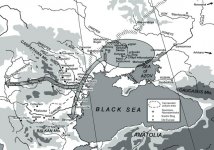
I already saw some time ago by looking at their designations that there are J-L283 from a whole lot of different sites.
Well as indicated by the Viminatium paper, and also increasingly modern Z631 diversity, it spread with some strong IA Illyrian culture, probably Mati.
I'll take a look at that Gudnja cave Z638 sample. But surely there will be plenty of Z638 results from BA Albania including that rumored find most likely.
But what can be said is that a bulk of people like Delmatae do not have many descendants today. Alot can change in 2000 years and it often does. Plenty of examples.
Good to see you back here posting, Aspurg. I remember sometime back that you mentioned an ancient L283 from Hungary, dated to about 400BC. I’m assuming that sample is the “La Tene” individual from Vas, Hungary. You also mentioned that there was another ancient L283 from Hungary very near the Mokrin site. I believe it was Szeged. There was some confusion and it seemed that this other sample might be the same as the Mokrin sample (same dates, about 2000BC), but you thought it might still be a separate sample because it had a bit more Yamnaya or western Yamnaya autosomal ancestry. When I look at Mokrin and Szeged on the map, they are very near Csongrad, Hungary. There was a branch of the Suvorovo people who split off around Moldova/Bulgaria area and moved into what is today Hungary around 4000BC. Evidently this group was called the “Csongrad” Suvorovo. I’m wondering if this could have been the vector that brought L283 into Central Europe and the Balkans?
Is there an upcoming Pannonia study on the way and, if so, any estimate on a possible publication date?
Aspurg
Banned
- Messages
- 661
- Reaction score
- 233
- Points
- 0
- Ethnic group
- Bædzænæg
- Y-DNA haplogroup
- E-A24070
- mtDNA haplogroup
- I1a1a
Good to see you back here posting, Aspurg. I remember sometime back that you mentioned an ancient L283 from Hungary, dated to about 400BC. I’m assuming that sample is the “La Tene” individual from Vas, Hungary. You also mentioned that there was another ancient L283 from Hungary very near the Mokrin site. I believe it was Szeged. There was some confusion and it seemed that this other sample might be the same as the Mokrin sample (same dates, about 2000BC), but you thought it might still be a separate sample because it had a bit more Yamnaya or western Yamnaya autosomal ancestry. When I look at Mokrin and Szeged on the map, they are very near Csongrad, Hungary. There was a branch of the Suvorovo people who split off around Moldova/Bulgaria area and moved into what is today Hungary around 4000BC. Evidently this group was called the “Csongrad” Suvorovo. I’m wondering if this could have been the vector that brought L283 into Central Europe and the Balkans?
Is there an upcoming Pannonia study on the way and, if so, any estimate on a possible publication date?
Thanks, now its the great time to be active again with all of these samples.
I had most difficulties locating exactly that Hungarian study J2b samples, but I just took a look at my estimates for IA J2b's location and they are Bő and Bük, right next to Gór, so I did pretty well, I wasn't able to tell exactly as there are several different sites there. So I can confirm that the IA J2b sample from the upcoming Hungarian study should be actually this sample as the datation is also very similar 350 BC per their diagram, and here 391-208 calBCE.
As for Mokrin, I know that Serbian Mokrin auDNA samples exist in that study but the Maros site seems very near Szeged, not in Serbia. Also there is an early Maros site and this is the Hódmezővásárhely—Gorzsa-Cukor-tanya, while the 1900-2000 BC site seems to be in Szoreg.
Early Maros site doesn't seem to have Y-DNA but it has something like 90 %+ Yamnaya profile quite different from the rest of Maros. I also identified this site not just by location but also by searching for sites in archeological records, and there is an early Maros site, methodology I used for the others.
And right here in this study we have a new Maros sample that is R-CTS7556+ maybe this one has some downstream positive SNP's, and he is fro mthe site of Čoka. Also there seems to be another R-CTS7556+ sample, in addition to oneI-L161 sample from Mokrin but they were first published here.
It seems going by the early Maros site that some Yamnaya group settled there and assimilated J2b and other locals who indeed might fit into that Suvorovo settlement (I'll have to learn more about that to say more).
Bar the IR2 Mezocsat culture sample, and some earlier Hungarian BB, Nagyrev Y-DNA finds almost all others seem to be new samples.
Also logically, I do not see any R-Z2103 colleagues of that J2b sample in terms of age and auDNA, and considering their dominance there should be at least some. It would be really weird if they choose for their Y-DNA diagram just the J2b sample out of all other Maros samples. This speaks in favor of a new Szeged/Szoreg EBA J2b sample. Maybe that was the hub for J2b within Maros culture. If there is just one Maros find from Szeged and it is J2b, maybe more testing reveals J2b dominance.
Not sure when this study will be out, I think surely next year.
Aspurg
Banned
- Messages
- 661
- Reaction score
- 233
- Points
- 0
- Ethnic group
- Bædzænæg
- Y-DNA haplogroup
- E-A24070
- mtDNA haplogroup
- I1a1a
Why is there no E-V13 in Iron Age Croatia? When in fact E-V13 is more popular than J2b in modern Croats, Bosnians and Albanians.
Any explanation for this?
Far more more popular. E-V13 to J-L283 ratio is much higher in these populations. I guess some got picked up by the Slavs..
And of course part of their V13 is of recent more Eastern origin, including Albanian origins.
But also probably effects of Hunnic invasions, and various resettlements.
This thread has been viewed 495824 times.
